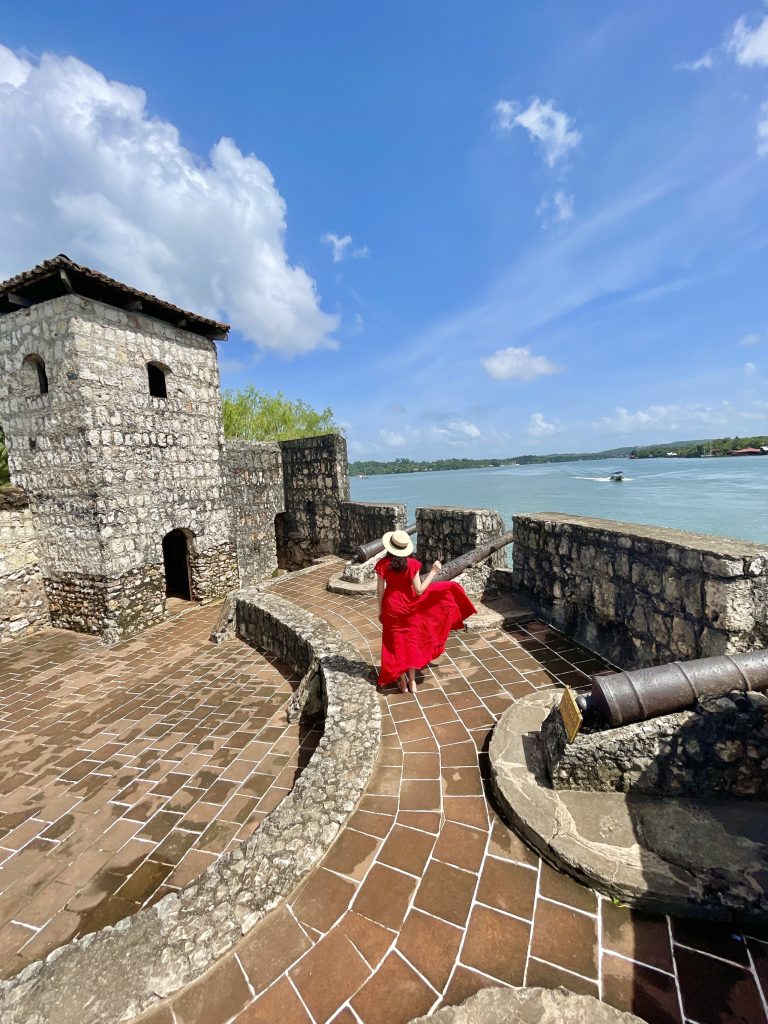Exploring the colonial ruins of Antigua Guatemala should definitely be at the top of your list of things to do in Antigua. From convents with gorgeous courtyards and crumbled cathedrals to stunning baroque churches this list of the best colonial ruins in Antigua has it all!

As someone who knows Antigua Guatemala well this city never ceases to amaze me. It’s like a time machine has been finally invented. As you walk the cobblestone streets of this beautiful 16th century city you feel like you have been transported back in time. The colonial buildings, fountains, churches, and courtyards all hold so much history that exploring all the ruins is almost impossible. But don’t worry, with a list of the best colonial ruins in Antigua, you can easily choose from the countless historic buildings set against the impressive backdrop of Agua Volcano. I’ve included a list of my favorite colonial ruins, so you can get a taste of this city’s essence. I have included among others the Convent of Capuchinas, the Cathedral in Antigua Guatemala and the ruins at the Hotel Casa Santo Domingo. But as you will realize, there are churches and interesting buildings everywhere you turn so don’t hesitate to explore and find your own favorites!
Brief History of Antigua Guatemala
Antigua Guatemala was founded in 1524 as Santiago de Guatemala. The city was destroyed by fire due to an uprising of the indigenous population and then reestablished in 1527. However, the city was largely destroyed as a result of earthquakes and an avalanche in 1541. A new location in the Valley of Panchoy or Pacán was inaugurated in March 1543.
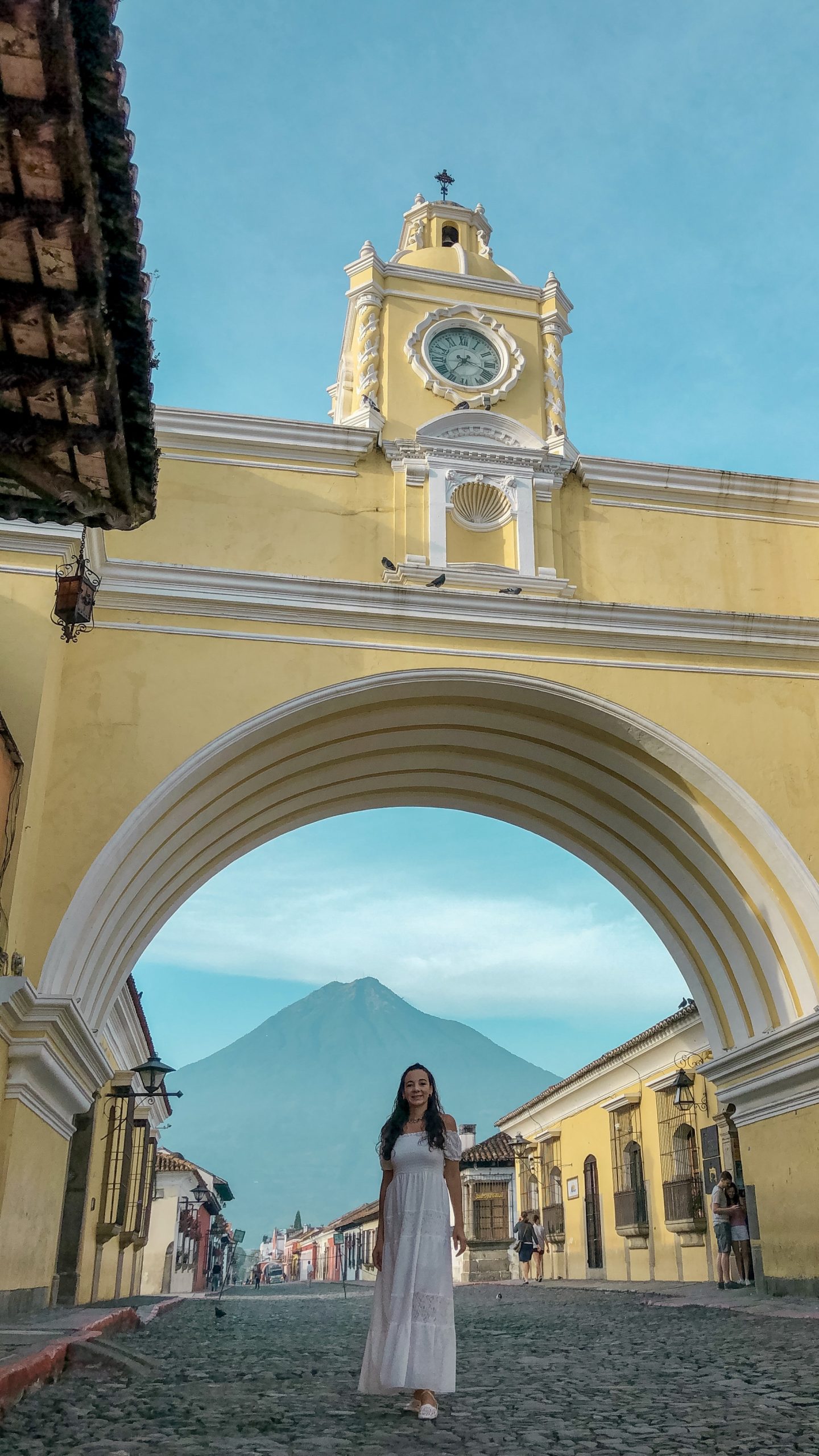
For the next 230 years, Antigua Guatemala served as the cultural, economic, religious, political, and educational center for the entire region. Then the Santa Marta earthquakes destroyed much of the town in 1773. As a result, the authorities ordered the relocation of the capital to a safer location. This became Guatemala City, the modern capital of the country. However, some residents stayed behind in the original town, which became referred to as “La Antigua Guatemala”.
Despite the natural disasters and the relocation of the capita, Antigua Guatemala has remained an important cultural and historical center. The city’s grid of north-south and east-west streets, which was inspired by the Italian Renaissance, is one of the best examples of town planning in Latin America. And most of the surviving civil, religious, and civic buildings date from the 17th and 18th centuries.
The colonial architecture in Antigua Guatemala is renowned for its distinctive regional stylistic variation known as Barroco antigueño. This style features decorative stucco for interior and exterior ornamentation, main facades with a central window niche and often a deeply-carved tympanum, massive buildings, and low bell towers designed to withstand the region’s frequent earthquakes.
Churches, Convents and Monasteries: Colonial Ruins in Antigua Guatemala
While many people tend to associate architectural ruins in Guatemala with Maya archaeological sites, the colonial ruins in Antigua are equally impressive. These ruins are remnants of the city’s past as the capital of Guatemala during the Spanish colonial period, until a series of devastating earthquakes forced a relocation. The city was abandoned for a long time wich helped preserve it just as it was back them. Today, Antigua has restored many of its colonial ruins as monuments to the past, allowing visitors to safely walk among the tumbled columns and gaze up at their blue-sky ceilings. These quiet places of beauty and reflection offer a peaceful and memorable experience.

There are so many beautiful churches and colonial ruins in Antigua. Depending on how much time you have you can choose the ones that sound more interesting to you. These ruins are mostly former churches and monasteries that have been preserved as cultural heritage sites. While some of the ruins can be seen only from the street and others are free to visit, some of the sites charge a few dollars to get in. They beauty makes them a great activity even for families with children. By the way, if you’re visiting Antigua Guatemala with your family make sure to check out my article on things to do in Antigua Guatemala with kids.
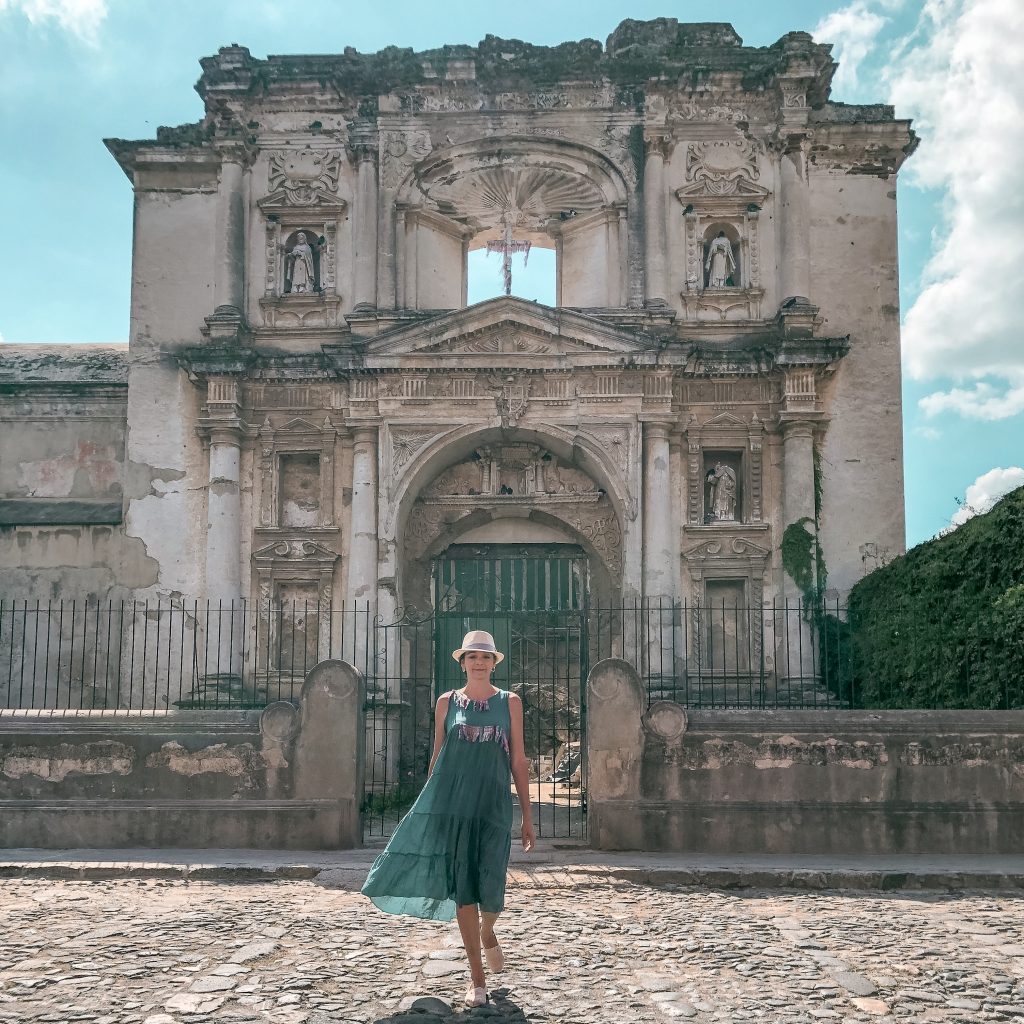
One thing to keep in mind is that the ruins are often tucked behind the facades of working churches. It’s impossible to image the hidden treasures that you can find behind an unassuming wall or through the back door of a church. This mystery and seclusion is one of the things that makes Antigua Guatemala such a magical place! Many tourists tend to focus on the more popular sites in Antigua, such as the Central Park, the Cathedral, or the markets. However by venturing off the beaten path to explore the lesser-known ruins you will uncover the real hidden gems in Antigua.
Convent of Capuchinas (Convento de las Capuchinas)
When you visit the Convent of the Capuchins ruins in Antigua Guatemala, you can’t help but feel like you’ve traveled back in time. The well-preserved cells, gardens, and courtyards transport you to the colonial era and immerse you in the atmosphere of the place. You’ll find that the surroundings are peaceful and serene, with the sounds of birds singing and a gentle breeze rustling through the trees.
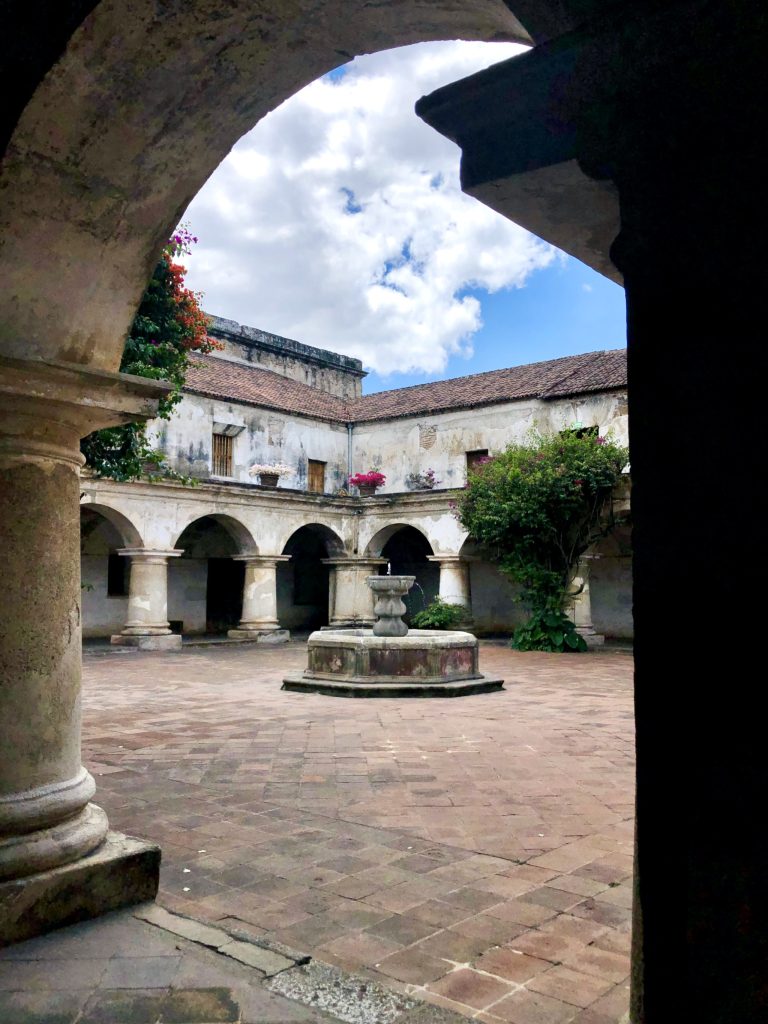
The architecture of the ruins is impressive, with stone walls, archways, and beautiful courtyards that make it easy to imagine the nuns who once lived there. You can almost picture them going about their daily lives, praying and working in the garden. The living quarters are simple, with small, spartan rooms that contain only a bed and a small desk.
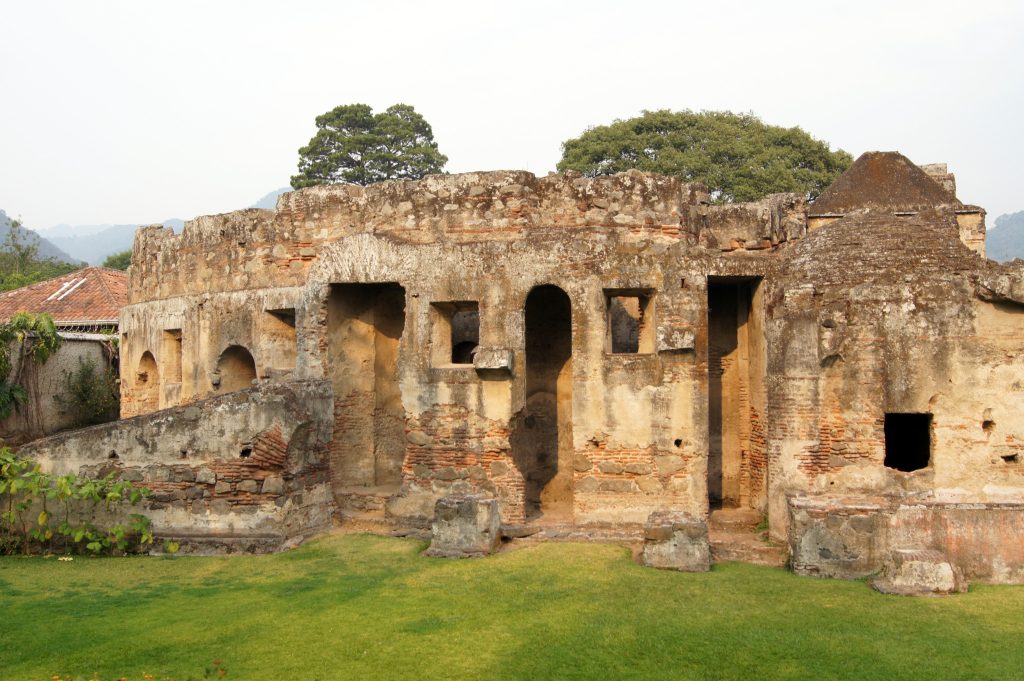
One of the my favorite areas in the complex is the round room beneath the Nun’s tower wich has amazing acoustics. Try singing quietly, and you’ll be amazed by thow the sound reverberate throughout the room. And don’t miss the 2nd-floor art display, which showcases colonial and pre-Columbian art and artifacts.
As I walk through these ruins, I always feel a sense of reverence for the nuns who once called it home and for the history of the place. It’s a humbling experience to be in the presence of such rich cultural heritage. This is one of my favorite places in Antigua and one I come back to again and again.
Important information
- Location: 2 Avenida Norte y 2 Calle Oriente, Antigua Guatemala
- Hours of operation: Monday to Friday from 9am to 5pm
- Prices: nationals Q5.00, Central American: Q15.00 Foreigners: Q40.00 (approximately $7)
Church of Santa Rosa Ruins
When you visit the Santa Rosa complex in Antigua Guatemala, you can’t help but be struck by the resilience of this stunning structure. Originally constructed as a convent for a sisterhood known for wearing white clothing in 1570, the complex was later converted into a church. Despite the ravages of time and the devastating earthquakes that shook the region in the 18th century, the church still stands tall and proud, a testament to the enduring spirit of the people who built it.
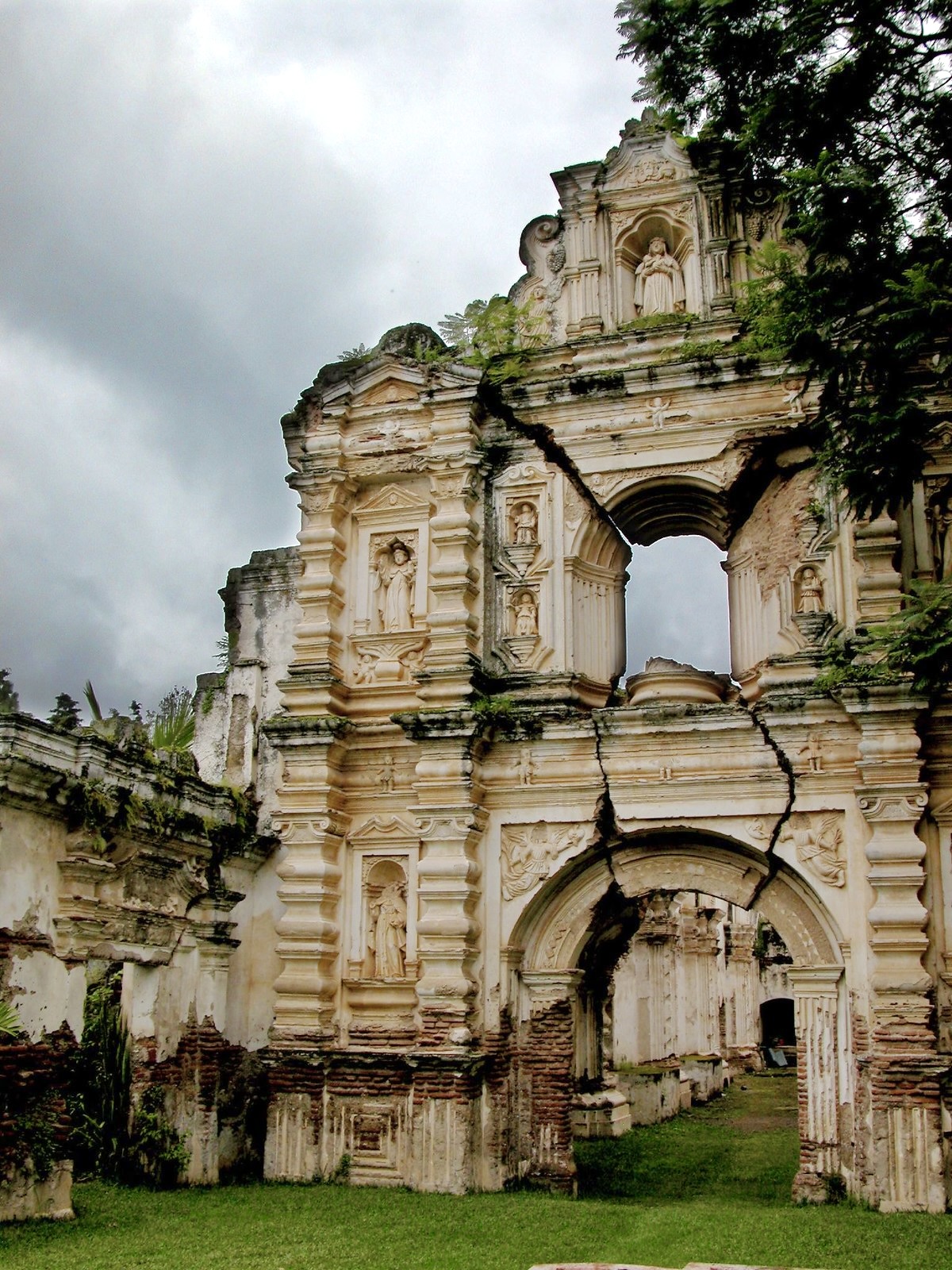
As you approach the complex, you can see two large cracks running through the main part of the building. These are a stark reminder of the power of nature and the challenges that the people of Antigua have faced throughout their history. However, the fact that the church still stands is a tribute to the ingenuity and craftsmanship of the builders who created it.

Despite the damage caused by the earthquakes, the intricate façade of the Santa Rosa church still bears the image of the patron saint of Lima, Santa Rosa de Lima. She is adorned with roses and holding baby Jesus in her arms. The façade also features depictions of several Dominican saints, including Santo Domingo, San Francisco, and San Vicente Ferrer. These beautiful sculptures and carvings offer a glimpse into the colonial-era art and architecture of Antigua. They are a testament to the skill of the craftsmen who created them.
Important information
- Location: Final de la Alameda de Santa Rosa, Antigua Guatemala
Santo Domingo Convent Ruins
When you visit the Church of Santo Domingo in Antigua Guatemala, you’ll be transported back in time to the 16th century. The ruins of this former convent are a fascinating sight to behold, and they offer a glimpse into the history of the area. As you walk through the site, you’ll see the remains of what was once the largest and richest convent in Antigua, which unfortunately fell to ruin after earthquakes in the 18th century.
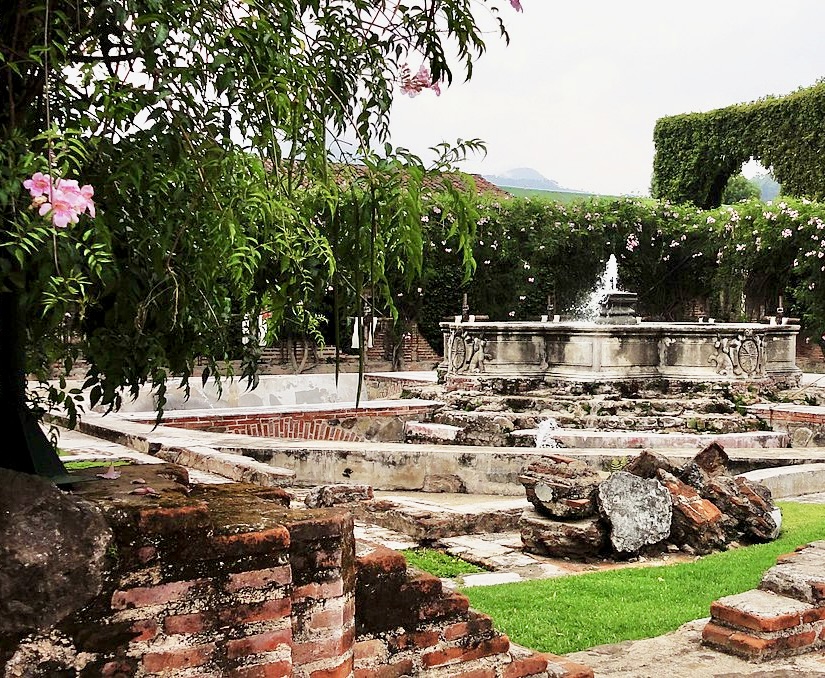
Despite the damage, the site has been excavated and made accessible to visitors. As you wander through the domestic areas, kitchens, chapels, stairways, and fountains, you’ll get a sense of the daily life of the nuns who once lived there. You can even see skeletons displayed behind glass, which is a haunting reminder of the past. There are also several museums on-site that showcase colonial and pre-Columbian art, archaeology, and silver work. These exhibits provide a deeper understanding of the cultural and historical significance of the site.

Personally, I highly recommend a visit to the Convento de Santo Domingo. The combination of well-preserved ruins and fascinating museums makes for a unique and enriching experience. It’s a must-see destination for anyone interested in the history of Guatemala and the cultural heritage of Antigua. So take your time, explore the site, and let yourself be transported back in time to a bygone era.
Important information
- Location: 3a Calle Oriente 28 A, Antigua Guatemala, Guatemala
- Hours of operation: Monday to Saturday 9 am to 6 pm. Sunday from 11 am a 6 pm.
- Prices: free
La Merced Ruins (Inglesia y Convento de Nuestra Señora de La Merced)
Located just a few blocks from the central park, this beautiful church and convent complex is an impressive example of colonial-era architecture and offers a glimpse into the region’s rich history.
The La Merced complex was constructed in the late 16th century and was one of the most important religious centers in Antigua. The church and convent were built by the Mercedarian Order, a group of friars who arrived in Guatemala in 1547 to evangelize the indigenous population. Over the years, the complex has been damaged by earthquakes and other natural disasters, but much of the structure remains standing and has been preserved as a historical landmark.
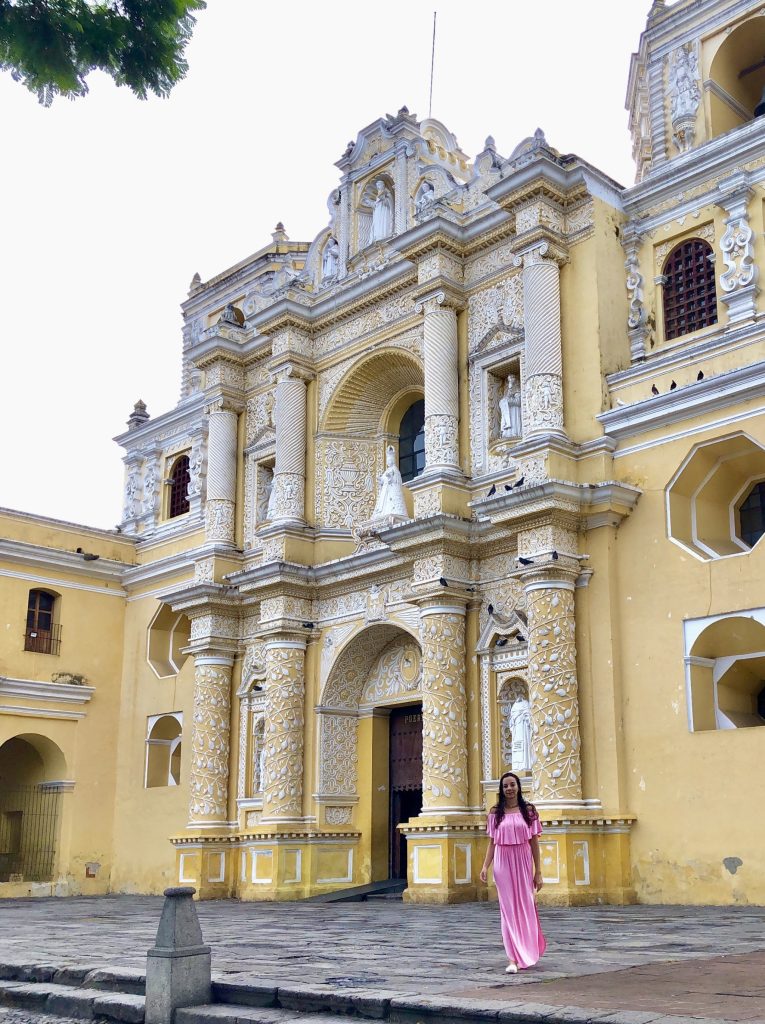
One of the main attractions of the complex is the beautiful baroque-style church, with its intricate facade adorned with carved stone figures and ornate decorations. Inside, visitors can admire the high vaulted ceilings and elaborate altar, which is made of gold leaf and is one of the most beautiful in Antigua. The church also features a number of interesting artifacts, including a painting of the Virgin Mary that is believed to have miraculous powers.
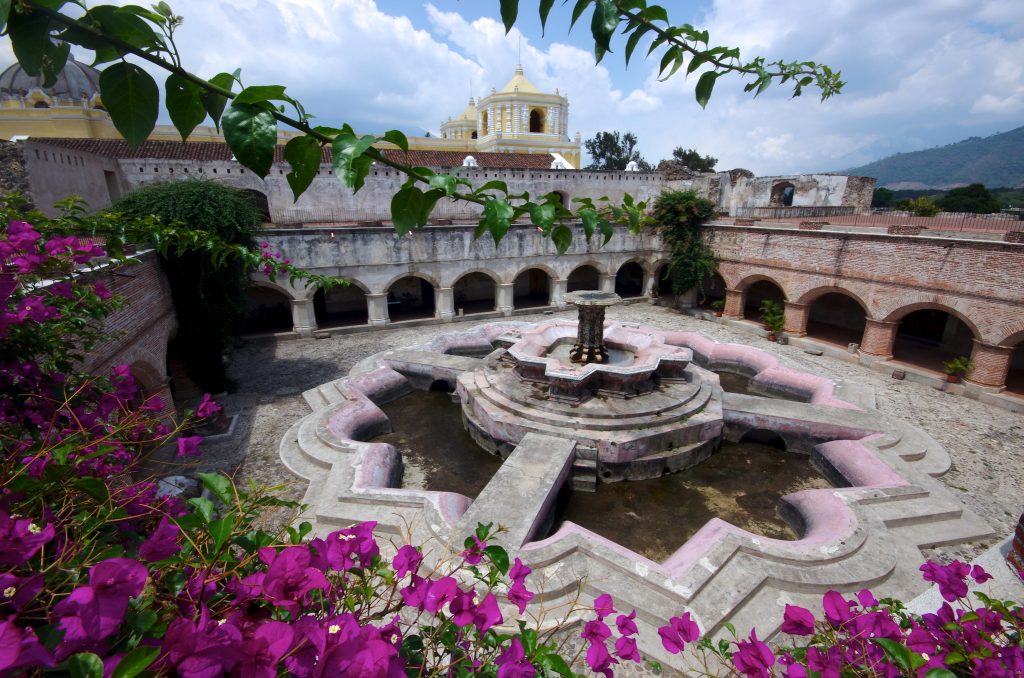
Adjacent to the church is the sprawling convent complex, which includes a number of beautiful courtyards and gardens. Visitors can wander through the ruins of the convent, exploring the various rooms and halls that were once used by the friars who lived there. One of the most impressive features of the convent is the large courtyard fountain, the largest in La Antigua Guatemala. It is actually three fountains in one and was not built in its current location. Originally known as the “Fountain of the Fish,” it was a Baroque-style fountain located in the Convent of San Francisco, about 1.5 kilometers away, and was moved in 1944 to its current location when the city was declared a National Monument.
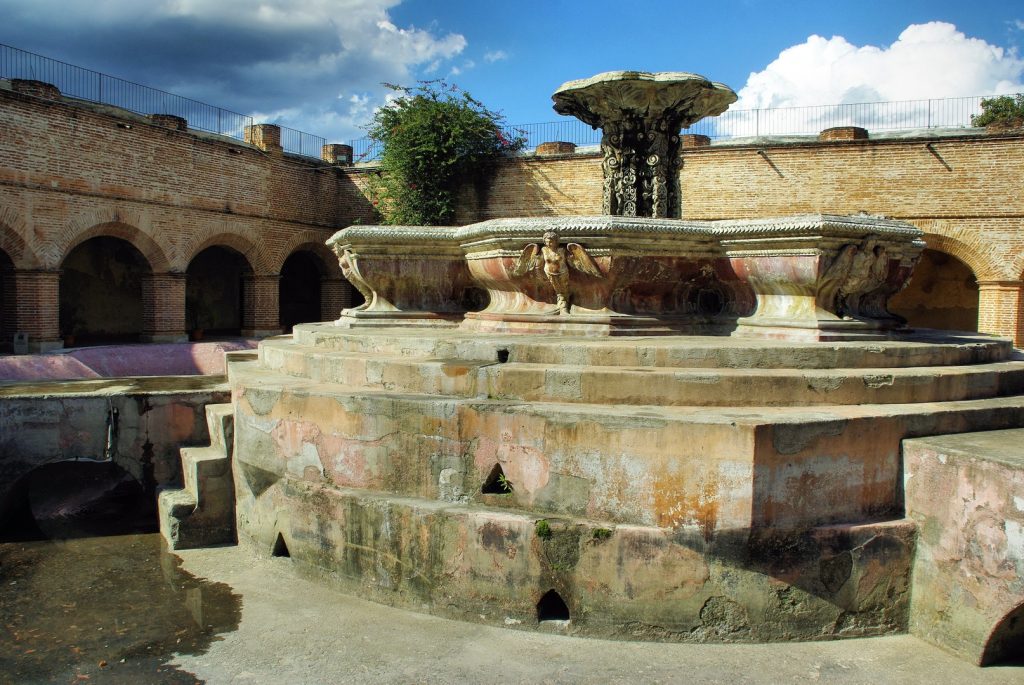
Important information
- Location: 6a Avenida Norte y 1a Calle Poniente, La Antigua Guatemala
- Hours of operation: 9am to 6pm
- Prices: Entrance to the church is free. Entrance to the Convent ruins is Q5 (approximate $1)
El Carmen Church Ruins
No longer active, the church can only be viewed from the outside (try peering through the bars used to protect it), but that gives you time to enjoy the popular handicrafts market right next door; an excellent place to buy gifts for your loved ones, though sometimes you have to know how to bargain if you want to pay a good price.

If you’re looking for a unique attraction to visit in Santiago de los Caballeros de Guatemala, the El Carmen church should definitely be on your list. While the church is no longer active, the ornate stonework and majestic columns make it a sight to behold. Despite suffering damage from earthquakes over the years, the facade has remained in relatively good condition and is a testament to the Guatemalan seismic Baroque style.
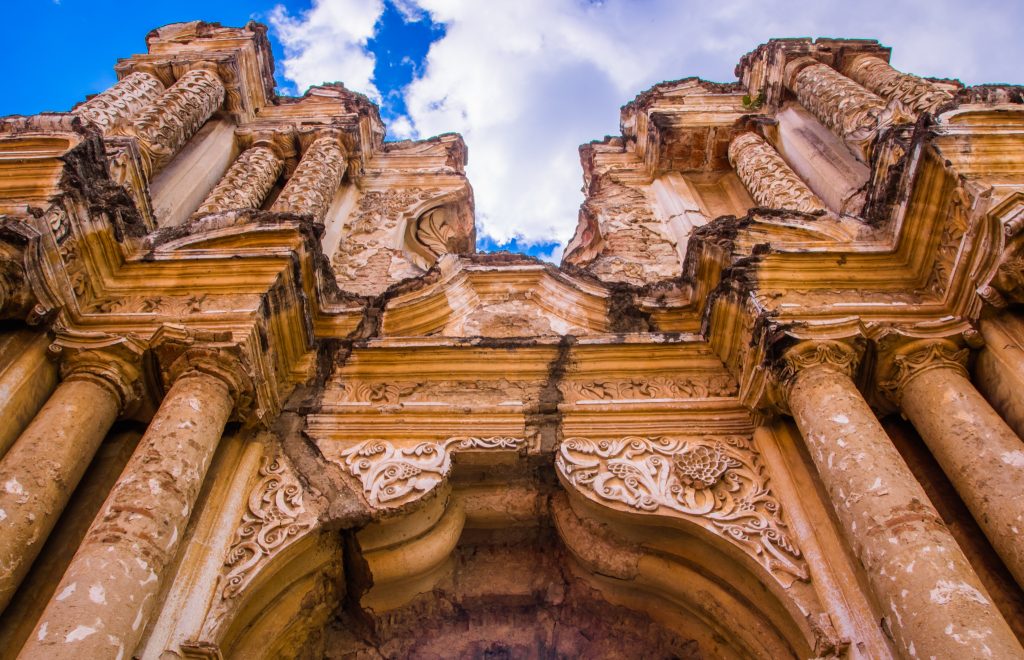
Although you won’t be able to go inside the church, take some time to admire the intricate details on the outside. You can even try peering through the bars that protect the church for a closer look. But don’t worry if you can’t go inside, there’s still plenty to see and do in the area. Right next door, you’ll find a popular handicrafts market where you can find unique and authentic gifts to bring back home. Make sure to take some time to explore the market and browse through the various artisanal crafts, from traditional textiles to handmade ceramics.
Important information
- Location: 3ra avenida Norte, Antigua Guatemala
- Hours of operation: all day and night, everyday. Can be seen from the street.
- Prices: free
Santa Clara Convent
If you’re planning to visit the convent and church, then you’re in for a real treat! This historic site has an interesting past – founded in 1699 by nuns from Puebla, it became a popular destination for affluent young ladies who wanted to take the veil. The nuns had a reputation for selling bread to high society, which only added to the site’s allure.
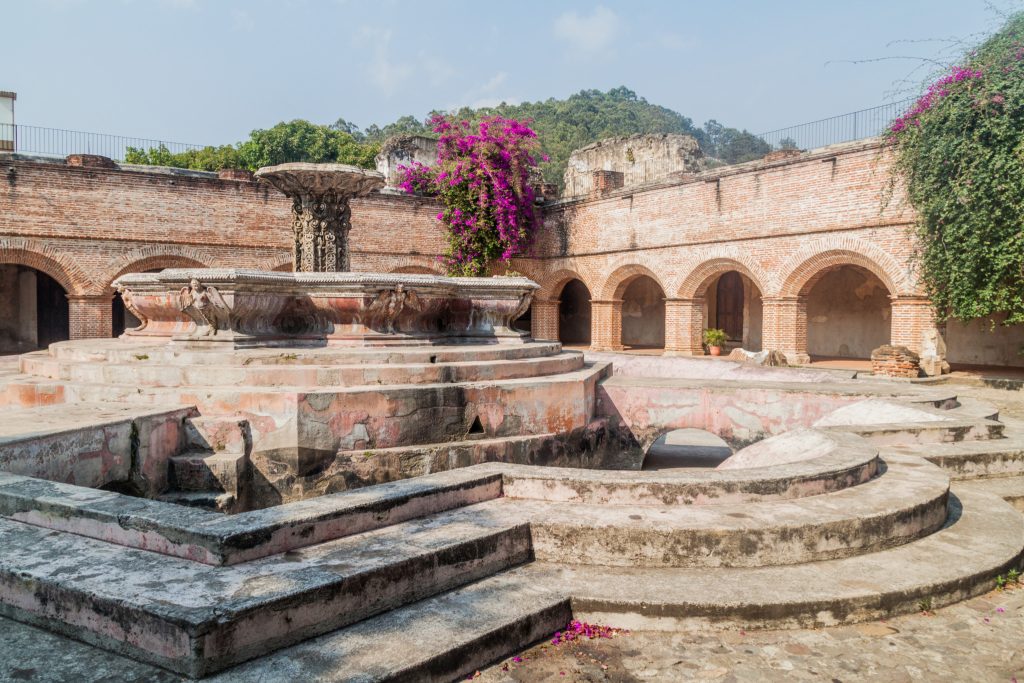
Unfortunately, the original convent was destroyed twice – once in 1717 and again in 1773. Luckily, the current building survived a major threat in 1976, and you can still see the impressively ornate facade that’s intact to this day.
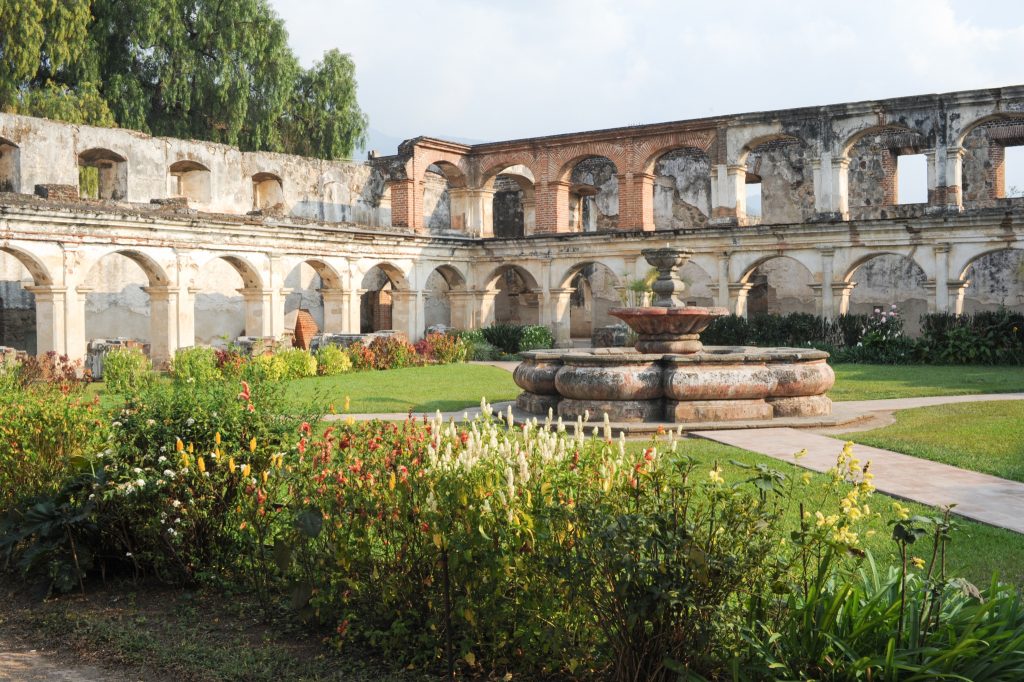
As you wander around, don’t miss the smaller garden filled with beautiful plants and flowers. You can even check out the original bread oven and the wash house. The courtyard with its central fountain is a real highlight, and you can’t forget to visit the church and see the underground tombs.
If you want to take a break and relax, feel free to bring a picnic or grab a drink and soak up the picturesque surroundings. The arches, openings, and layers of exposed walls make for some great photo opportunities, with the volcano in the background providing an especially impressive backdrop.
Important information
- Location: 2nda Avenida Sur no. 11, Antigua Guatemala
- Hours of operation: Monday to Friday from 9am to 5pm
- Prices: nationals Q5.00, Central American: Q15.00 Foreigners: Q40.00 (approximately $7)
San José Cathedral
When you step into the Church of San José in Antigua, Guatemala, it’s hard to imagine the grandeur of the original cathedral that once stood on this site. The first cathedral was constructed in 1545, but it was poorly built and constantly in need of repairs. A devastating earthquake in 1583 destroyed much of the roof, leading to the construction of a new cathedral that began in 1670.

The construction of the new cathedral took 11 years and the labor of many conscripted Maya workers. But the result was nothing short of spectacular: a massive dome, five naves, 18 chapels, and a central chamber measuring 90m by 20m. The altar was adorned with mother-of-pearl, ivory, and silver, while the walls were covered in carvings of saints and paintings by renowned European and colonial artists.
Despite surviving the 1689/1717 earthquakes, the walls of the cathedral were weakened, and the devastating 1773 earthquake brought them crashing down to the ground. Today, only two of the chapels remain, which have been restored as the Church of San José. The church is home to an impressive colonial sculpture of Christ by Quirio Cataño, who also carved the famous Black Christ of Esquipulas.
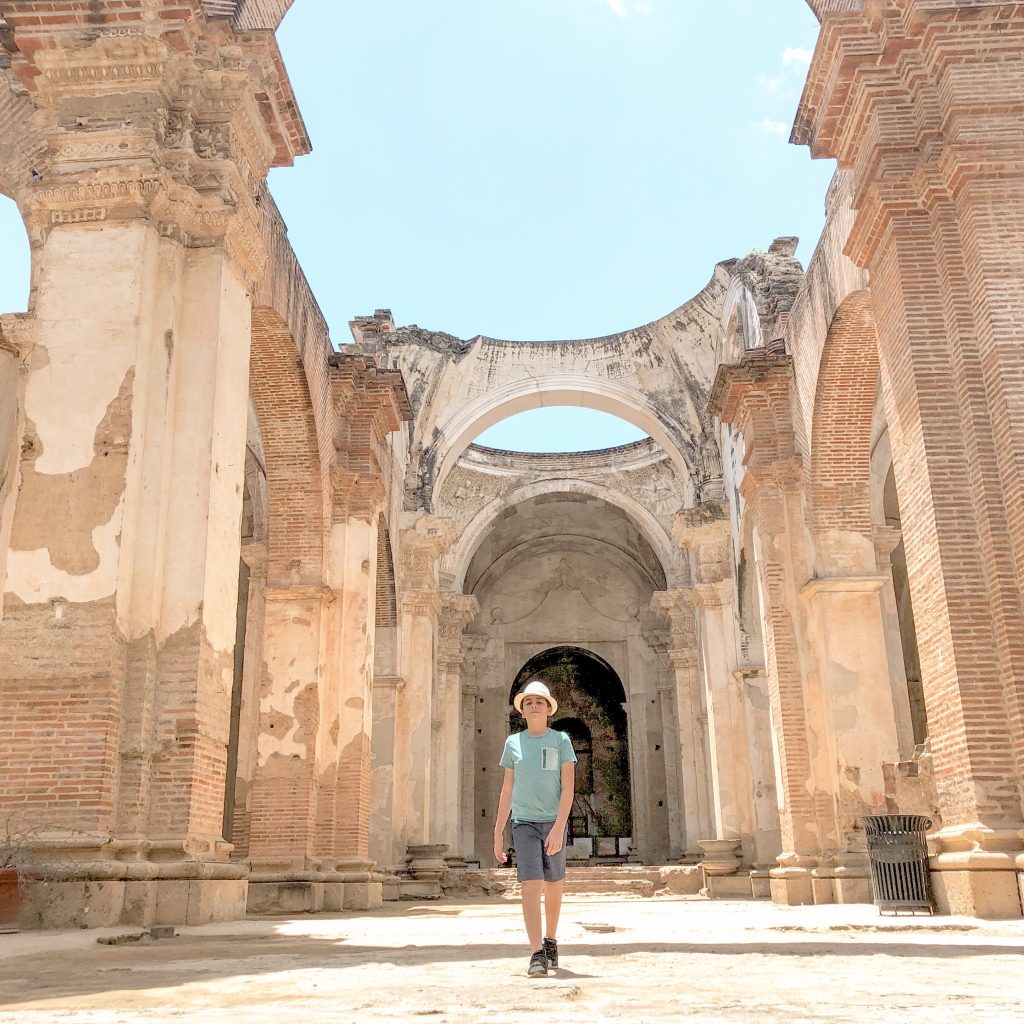
Behind the church, you can see the ruins of the rest of the cathedral, which are accessible from 5 Calle Oriente. The once magnificent structure now lies in ruins, with a mass of fallen masonry, broken arches, and hefty pillars. The moss-covered and cracked remnants of the great original cupola now form a window to the sky. At the rear of the original nave, steps lead down to a burial vault, blackened by candle smoke, which is still regularly used for Maya religious ceremonies.
Important information
- Location: the cathedral is located in 4 Avenida norte, 5 Calle oriente and parque Central. The entrance to the ruins is on the side of the cathedral’s main entrance on Calle 5a Oriente.
- Hours of operation: Monday to Friday from 9am to 5pm
- Prices: nationals Q10.00, Foreigners: Q20.00 (approximately $4)
Society of Jesus Church and School
The Church of the Society of Jesus is one of the many historical buildings in Antigua, with a fascinating history that dates back to the 16th century. Founded by the Jesuits, the temple was initially meant to be a school, as education was a top priority for the Society. The school was named after Saint Luke, who was highly respected by the Jesuits.
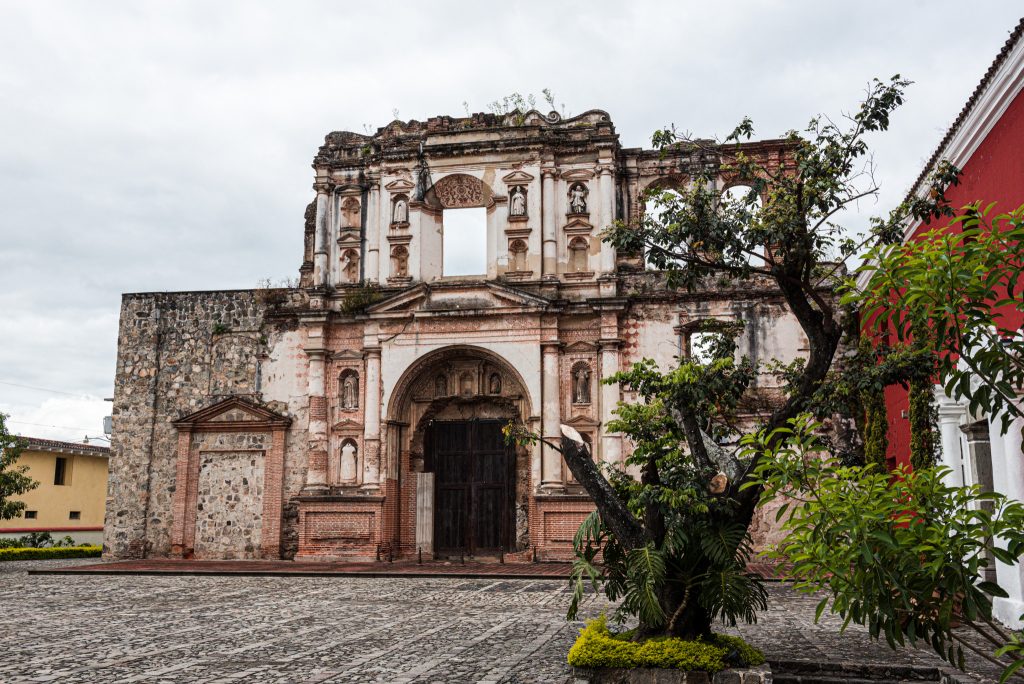
The San Lucas School, as it was called, had a small staff of only thirteen priests in 1653, yet it had a significant impact on the cultural and educational life of the Capitanía General of Guatemala. It was the most prestigious school in the city, and its graduates consisted of most of the elite members of society. After graduating from the Royal and Pontifical University of San Carlos, many of the secular students went on to hold high-ranking positions in the country.
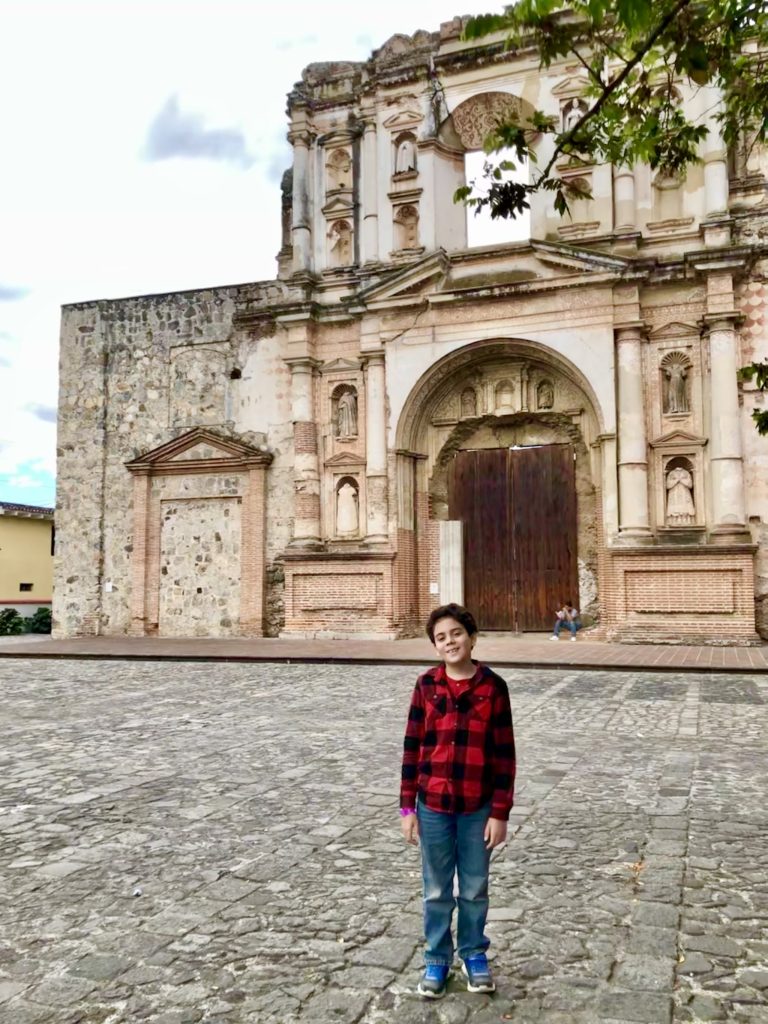
In 1717, a powerful earthquake hit the city and destroyed the San Lucas School building. However, the Jesuits rebuilt the structure three years later, and it went on to serve as a market for Guatemalan handicrafts until 1992. At this point, the International Cooperation Agency for Development from Spain committed to restoring the school building in exchange for being able to use it to create an international educational center. The National Council for Antigua Guatemala Protection gave its blessing for the project, which meant that the historic building would continue to play a significant role in the education and cultural life of the city. Visitors can still admire the beauty of the temple and learn about its rich history to this day.
Important information
This is a standing facade only. You can not access the ruins and this facade can be seen from the street at any time of the day or night.
- Location: 4ta Calle Poniente no. 140, Antigua Guatemala
- Hours of operation: all day and night, everyday. Can be seen from the street.
- Prices: free
San Jerónimo Convent
If you’re looking for an impressive and historically-rich site to visit, San Jeronimo is definitely worth your time. This ruin was initially built as a school in the first half of the 18th century by the Mercedarians, a Catholic order. Although it is now a large ruin, it still remains an impressive and beautiful structure. You’ll find its gardens to be particularly enchanting, intertwined with the enormous blocks of fallen masonry and crumbling walls that make up the site.
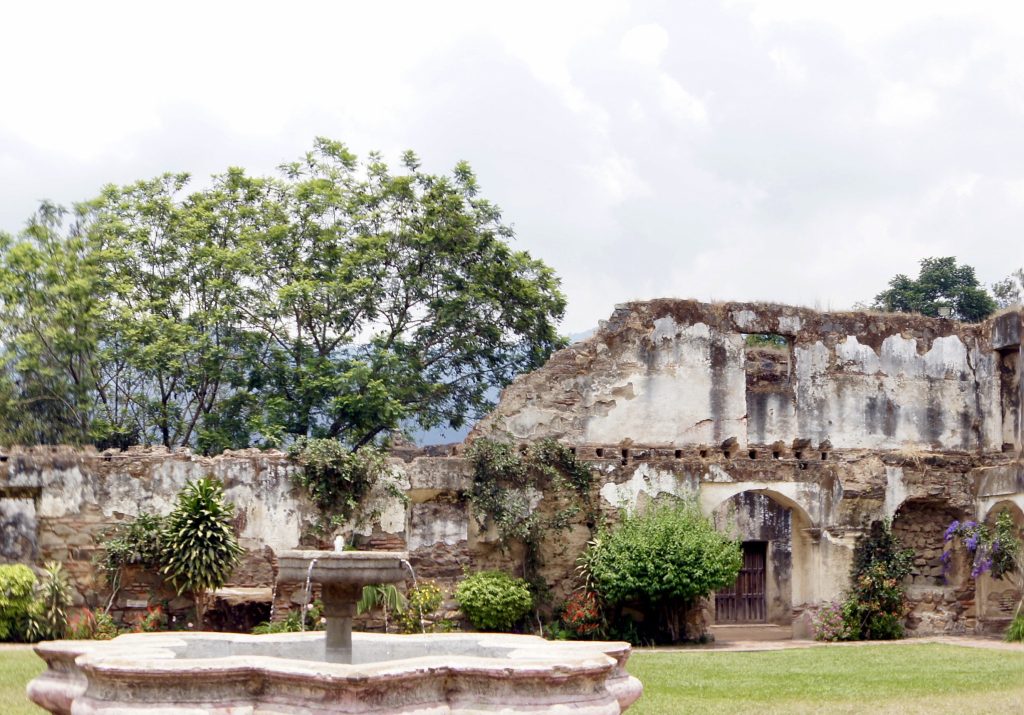
Locals seem to be particularly drawn to San Jeronimo, and it’s often used as a romantic spot for couples or even as a venue for classical music concerts. As you explore the site, you can still climb several stairways that provide a good vantage point to view the central courtyard and its water fountain, with the stunning Agua Volcano as a picturesque backdrop.

Do note that a small fee may apply to enter the site, but the experience is definitely worth the cost. San Jeronimo’s opening hours are daily from 9am to 5pm. So, pack a picnic, bring your camera, and take in the stunning beauty of this magnificent ruin.
Important information
- Location: Calzada Santa Lucía Norte, Esquina, Antigua Guatemala
- Hours of operation: Monday to Friday from 9am to 5pm
- Prices: nationals Q5.00, Central American: Q15.00 Foreigners: Q40.00 (approximately $7)
La Recolección Ruins
If you’re a history buff or a photography enthusiast, you won’t want to miss La Recolección, which lies just behind the San Jerónimo Convent. It’s an even larger and more chaotic ruin. It has huge chunks of the roof and walls piled high in the middle of the church. Even if you’re not into history or photography, the place is still worth a visit – it’s great for picnics on the grass, and perfect for letting the kids run aroundand explore.
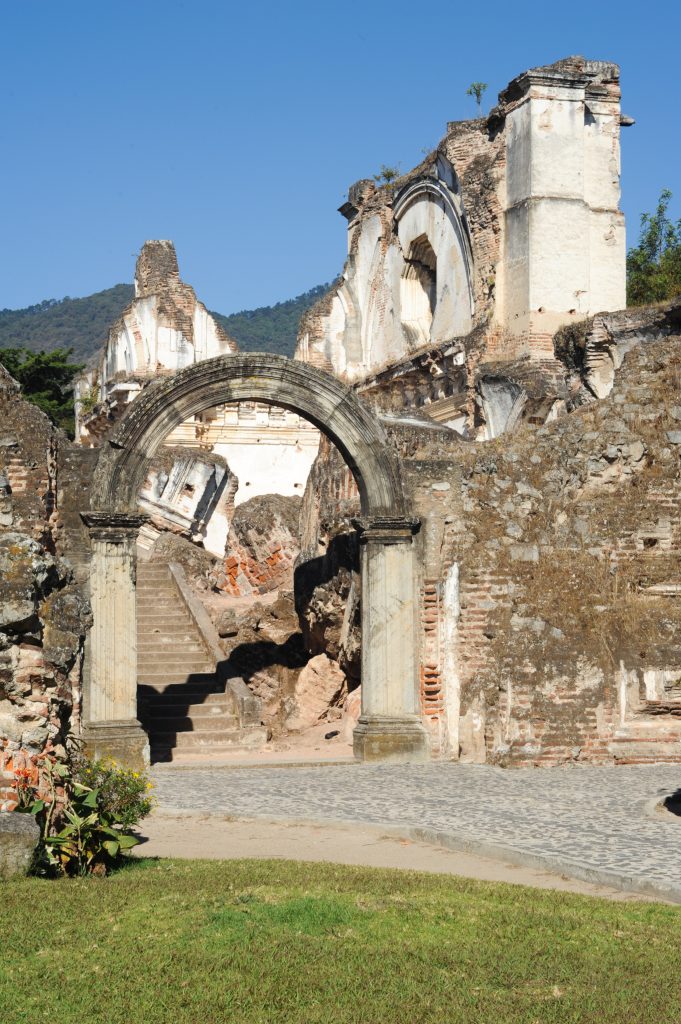
The friars of the Recollects first arrived at the site in the 1680s, and requested permission to build a monastery. However, it wasn’t until 1701 that they were finally allowed to begin construction, and it took another fourteen years to complete the cloisters, library, and infirmary. Sadly, the architectural complex was brought to the ground by a massive earthquake just a few months after completion. It was rebuilt, only to be hit again by earthquakes in 1751, and more severely in the devastating Santa Marta earthquakes of 1773.

Today, the ruins are surrounded by parkland and are a protected national monument. You can still access the cloisters for a small fee, which is definitely worth it if you have the extra cash. It’s a testament to the incredible power that nature has over humans, and the beauty that can emerge from even the most devastating tragedies. Whether you’re interested in history, photography, or just a fun day out with the family, La Recolección is a must-see destination.
Important information
- Location: 1era calle Poniente no. 55, Antigua Guatemala
- Hours of operation: Monday to Friday from 9am to 5pm
- Prices: nationals Q5.00, Central American: Q15.00 Foreigners: Q40.00 (approximately $7)
Getting To Antigua, Guatemala
Flying to Antigua
If you’re planning a trip to Antigua, the best way to get there is by flying into the La Aurora International Airport in Guatemala City. This airport receives flights from many major cities, so you should have no trouble finding a suitable flight.
Transport from the Airport
Once you arrive at the airport, you’ll have a few options to get to Antigua. You can take a taxi, shuttle, or use a ride-sharing service like Uber. Renting a car is also possible, and all of these services are available right outside the luggage area. However, I recommend taking a shared shuttle from the airport to Antigua. It’s not only affordable but also safe. It will take you about 45 minutes to reach Antigua from the airport.
Local Bus Option
If you’re looking for a cheaper, more local experience, you can take a bus from Guatemala City to Antigua. This option is slower and less comfortable than the other options, but it’s more budget-friendly. Keep in mind that pickpocketing can occur on public buses, so be sure to keep an eye on your belongings. This option is best if you’re adventurous, know some basic Spanish, and are familiar with using public buses in Latin America.
Where to Stay in Antigua
When picking where to stay, finding a hotel close to Parque Central and the Arco de Santa Catalina is a good idea. Here are some suggestions for centrally located hotels in Antigua Guatemala:
- Hotel Museo Casa Santo Domingo: This luxurious hotel near Plaza Central used to be a convent but now offers a blend of history and modern comforts. It’s one of my favorite places to stay in Antigua, with its museums, beautiful gardens, and excellent restaurants.
- Porta Hotel Antigua: Near the Arco de Santa Catalina, this hotel mixes traditional charm with modern comforts. My family loves its lovely gardens, inviting pool, and excellent service.
- Hotel San Rafael: A fancy boutique hotel near Plaza Central known for its elegant colonial style and top-notch service. I enjoy the quiet and cozy atmosphere here, perfect for those wanting a bit of luxury.
- Villa Las Mil Flores: This cozy hotel near the Arco de Santa Catalina offers a peaceful setting. My favorite part is the lovely garden and attentive staff, making it great for a relaxing stay in the city.
- Las Cruces Boutique Hotel: Found near the Arco de Santa Catalina, this boutique hotel mixes luxury with traditional design. I enjoy its beautiful interiors, top-notch service, and peaceful vibe.
- Adra Hostel: For those on a budget, this hostel near Plaza Central offers a comfy and social atmosphere. It has dorms and private rooms, a shared kitchen, and is excellent for meeting other travelers.
- La Sin Ventura: A budget-friendly hotel near Plaza Central, perfect for travelers seeking simple, clean, and comfy rooms. It’s conveniently located near attractions and has friendly staff.
Other Guatemala Travel Articles You Might Like
Best Mayan Ruins To Visit In Guatemala: The remains of the once-dominant Mayan cities offer a glimpse into one of the greatest early civilizations, whose technological advancements are still quite impressive to this day. While Tikal is a must-visit, and on everyone’s list of best things to do in Guatemala there are lots of other Mayan sites in Guatemala worth visiting.

Best Things To Do In Lake Atitlan With Kids: Lake Atitlán is one of the most popular destinations in Guatemala and a great place to visit with kids. The breathtaking views framed by volcanoes, the quaint towns, and the colorful Mayan culture make Lake Atitlan an ideal destination for families. This article includes all our favorite things to do around Lake Atitlán with kids, from Panajachel and Santa Catarina Palopó to smaller towns like San Antonio Palopó.

A Quick Guide To Río Dulce In Guatemala: Río Dulce is one of the most beautiful destinations in Guatemala, often overlooked. This area overflows with beautiful nature, colonial history, unique culture, and fantastic food. This quick guide to Rio Dulce covers the best things to do, where to stay, and what to eat.
